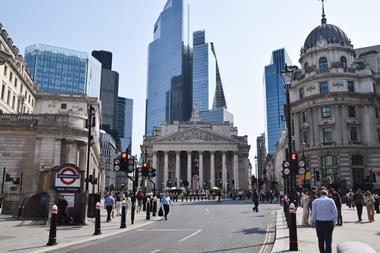The name `Coca-Cola' is worth $72.5 billion. Not bad for two four-letter words. Lee Coppack looks at the rises and falls in brand value, and at the hot topic of reputational risk.
In 1999, THE international consultancy Interbrand valued Coca-Cola at $83.8 billion. One year later, Coca-Cola was still the world's most valuable brand, - valued at $72.5 billion - but the number two brand, Microsoft, was snapping at its heels. Between 1999 and 2000, Microsoft's brandvalue rose by 24% to $70.2 billion.
Richard Tomkins wrote of the survey in the Financial Times on 18 July 2000: "It is the end of an era for Coca-Cola. Some 114 years after Dr John Styth Pemberton first concocted the drink in the basement of his Atlanta home, its decades of supremacy as the world's most valuable brand seem about to draw to a close."
The primary reasons: lacklustre sales, an awkwardly handled product recall, a block by European regulators of planned acquisitions, a US race discrimination lawsuit costing $188 million.
Not so long ago, the idea of branding would call to mind old cowboy films with scenes of thundering steer. The beasts were branded to show ownership in the herd. Today, the term brand is applied to products, companies, organisations and even individuals - in fact to anything which has or aspires to a distinct image.
From an insurance perspective, it is simplest to make a distinction between brands, which can be bought and sold like any other asset, and corporate reputation, which remains linked to an individual company or group of companies.
For companies in fast moving consumer goods, such as food and drink, fashion and cosmetics, brands are their most important assets. A valuable brand can generate a premium price or exceptional sales for its product or service. To do this the consumer has to believe that the branded product has additional value. This is often described as brand equity and is based on perception.
"Luxury goods companies have discovered that by putting a coveted brand name on a T-shirt, you can sell it for three or four times the price it would usually fetch. The same applies to leather goods, jewellery and perfume," commented Paula Hawkins on the high fashion market in the Independent on Sunday
A survey by the market research organisation MORI in May 2000 asked the following question: Assuming comparable price and quality, which factors would persuade you to choose one product over another?
Customer service 52%
Convenience (outlets/internet) 41%
Brand name/image 26%
Treatment of employees 15%
Impact on environment 14%
Clear social/environmental policy 12%
Company support of community 11%
None of the above 3%
The survey shows the importance of brand name and image.
With luxury goods, a large part of a brand's value proposition is that it is exclusive because of price or controlled distribution. Even for comparatively humble Levis, this made it worthwhile to fight in the European Court of Justice against plans by supermarket chain Tesco to import its branded jeans through cheaper third party suppliers outside Europe and sell them at around £20 less than the usual prices. Paula Hawkins comments: "for those products to be stacked on shelves in Tescos alongside the bread and milk could do serious damage to the brand. In fashion, you have to remember that if everyone else has it, it is simply not worth having."
Counterfeiting or passing off is another threat to brand image because consumers lose trust in what they are buying. Counterfeiters frequently attack high unit-price items that are, at least ostensibly, easily duplicated, so the latest children's craze is a regular target. In December 1999, the Massachusetts State Department of Education warned consumers: "BUYER BEWARE: Counterfeiters are flooding the market with fake Pokémon cards. More than $17 million dollars of counterfeit Pokémon products was seized in the United States in the past six months."
Valuing brands
Only comparatively recently has anyone started to put a monetary value on brands. One reason is that there wasn't a need to do so earlier. Brands created by the owner do not appear on the company's balance sheet under most accounting conventions. This includes many of the world's most valuable brands. For example, Coca-Cola's total corporate assets shown on its provisional balance sheet for the 2000 year are $21.6 billion, compared to the estimated brand value of $72.5 billion. The difference is recognised in the price of its shares; its market capitalisation in the first week of February 2001 was $150 billion.
Brands will appear on the company's balance sheet only if they have been acquired, but the buyer may be obliged to write off the value as part of goodwill, either immediately or over time, no matter how much it does to enhance the ability of that asset to generate profit for the business. The converse also applies; if the brand has never been shown on the balance sheet, there is no need to write it down if it is damaged.
Accounting bodies are now struggling to find ways to reflect the modern economy where value is created in the form of intellectual capital, intangible assets, business reputation, strategic partnerships and the like.
A gradual change is taking place. Brand trading is growing, with consolidation in many industries an important factor. Anglo-Dutch conglomerate Unilever has been selling groups of its brands to comply with a European Commission condition for approval of its acquisition in 2000 of the US company Bestfoods, the maker of Knorr bouillon and Hellmann's mayonnaise. An article in the Financial Times on 22 January said that Unilever was expected to use the proceeds from its disposals to help fund a bid for Clairol, the hair care brand put up for sale by Bristol Myers Squibb last September.
To buy and sell brands, someone has to value them and put a figure in both the buyer's and seller's accounts. Interbrand, for instance, developed its method for valuing brands over 10 years ago. It begins with the economic profit generated by the brand for the underlying business. The valuation process examines three areas: the future economic earnings the branded business is expected to generate, the role of the brand in generating those earnings and the risk profile of the expected earnings.
Under UK and International Accounting Standards (IAS), companies can now capitalise their acquired goodwill, including brands, and they have to write down the value if the asset is impaired. Therefore, someone has to be able to calculate the damage.
Insurers covering brand related risks like product recall have generally preferred to use a more transparent method of assessing loss, such as loss of sales or profits, rather than trying to quantify and indemnify brand damage.
In 1998, however, Ernst & Young in London developed a method for valuing brands for use by the Kiln syndicate at Lloyd's. It takes into account the following factors:
Using these measures, the brand owner and underwriter can agree a value to be insured when the policy is underwritten. It forms the basis of comparison and, therefore, the measure of loss after incident.
Brand risks
The beauty of the brand is in the mind of the beholder; the perception can change. If brand damage can be valued, it paves the way for financial remedies, such as insurance. For insurers, the critical issue is whether they are being asked to underwrite a defined and quantifiable exposure or a business risk.
Ian Harrison, active underwriter of Beazley syndicate 623 at Lloyd's which writes brand-related risks such as product recall, says the most serious threats to brand value come under two headings:
Short term: a crisis event that is not managed well - for example a defensive or half hearted response to a product contamination incident followed by a grudging recall. Adverse publicity, probably on a fairly wide scale, is a major element, because reputation is perception driven. A recent example is the linking of Firestone tyres in August 2000 with fatal accidents involving the Ford Explorer.
Long term: failure to reinvest in the brand and keep up with the product life cycle. This could involve a gradual degradation in quality, inadequate technological development or lack of response to changing consumer demands. Marks & Spencer's current problems have been blamed on the last of these.
Management decisions are critical. Sir Richard Branson has made his Virgin brand one of the best known in the world and successfully traded on his people's entrepreneur image. The Virgin brand encompasses 170 or so businesses that span the range from transport to financial services and condoms. In the last year, however, concern has been growing, as the Financial Times noted in December 2000, that some setbacks - rejection by the National Lottery Commission of his bid to run the lottery in favour of Camelot and his reaction to it, and criticism of Virgin trains - could have a knock-on effect on other parts of the brand family.
As a delayed and angry train passenger wrote to Marketing Week on 25 January this year: "You say Sir Richard Branson has stolen a march. But when he bought Virgin trains he made the biggest mistake of his career and probably damaged the whole Virgin brand."
Insurability
At least some element of mischance is the key to insurability, along with the ability to quantify exposure.
Insurers such as Lloyd's syndicates and AIG cover risks associated with brand damage, such as accidental and malicious product contamination. They generally do not try to indemnify the cost of brand damage but provide cover for the costs of recall and extra costs of working involved with an incident.
Policies may also pay for specialist consultants to help limit reputation damage and - more recently - to help with the costs of brand restoration, such as additional advertising and special offers, for a defined period after the event. Another innovation is a brand protection policy that helps tackle the effect of unpredictable, bad publicity by paying for the cost of expert advice.
Willis subsidiary Special Contingency Risks is to launch a new crisis management and reputation protection product, Brandsaver. Underwritten by a panel of five Lloyd's syndicates, it will reimburse the fees and expenses of consultants who can advise on how to react to adverse publicity and rebuild the brand.
Insurance can also cover the costs of defending brands and their intellectual property components. The so-called "advertising injury" clause often included in general commercial liability policies is likely to provide coverage against most claims for trademark infringement because they arise in the course of advertising or marketing the policyholders' products.
The market for brand protection insurances is growing but remains small and specialist. The risks of underwriting brand value are still regarded as those of the shareholder or venture capitalist. As former senior brand manager David Abrahams, now managing consultant with Marsh Strategic Risk Consulting, explains: "Frequent and enduring erosions of brand value result from a failure by the company to maintain effective brand saliency and the relevance of its value proposition in the face of external change. Continuous and consistent renewal is one vital key to brand survival."
Hosted by comedian and actor Tom Allen, 34 Gold, 23 Silver and 22 Bronze awards were handed out across an amazing 34 categories recognising brilliance and innovation right across the breadth of UK general insurance.













































